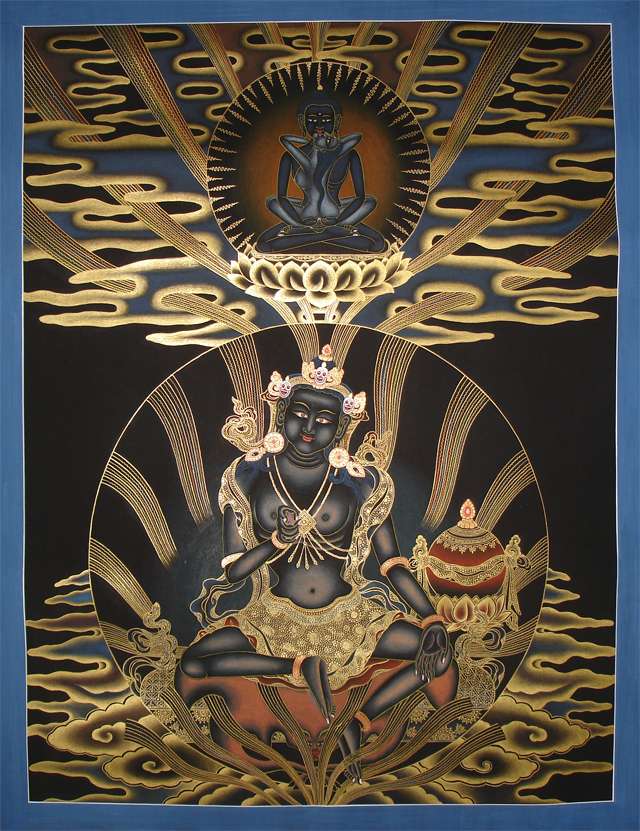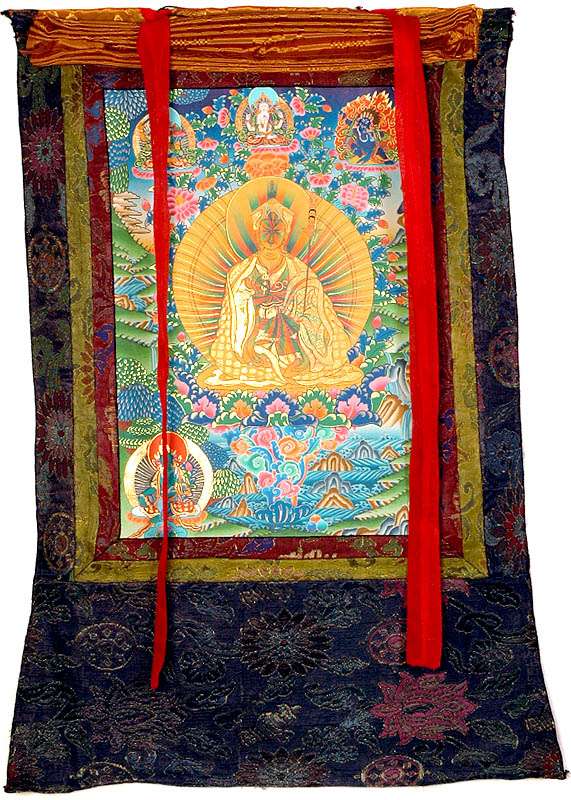|
Garab Dorje "was the first master of Dzogchen,
who himself received transmission through direct visionary contact with
the Sambhogakaya. Dzogchen teachings were taught for the first time on this
planet in this time cycle by Garab Dorje, who manifested a birth in a Nirmanakaya
form as a human being in the third century B.C.E., in the country of Ogyen,
which was situated to the north west of India. He spent his life there teaching
to both human beings and the dakinis. His final teaching before he entered
the Body of Light was to summarize the teachings in Three Principles, sometimes
known as "The Three Last Statements of Garab Dorje."
He
left behind this testament for all the Dzogchen practitioners of the future.
The Three Statements of Garab Dorje are:
"Introduce in the state
directly" refers to the transmission by the master, who, in various
ways, introduces and brings the disciple to understand the condition of "what
is", the individual's primordial state. This is the Base.
"Do
not remain in doubt" means that one must have a precise knowledge of
this state, finding the state of the presence of contemplation which is
one and the same in all the thousands of possible experiences. This is the
Path.
"Continue in the profound knowledge of self-liberation"
is the Fruit. That means, the complete and unchangeable knowledge of self-liberation
is totally integrated with one's daily life and in all circumstances one
continues in that state. All the hundreds and hundreds of original texts
of Dzogchen can be considered to be an explanation of these three verses
of Garab Dorje." (from "The Crystal and the Way of Light"
and "Dzogchen, the Self-Perfected State" by Chögyal Namkhai Norbu
)
Overview of Dzogchen
Teachings
Our essential being, that what we were, what we
are and what we always will be, is a state of awareness that is primordial
pure. Our normal mind and consciousness is always obscured by impurities
of emotions and thoughts.; but our essence is total purity. This is also
called the Natural State of our being.
This primordial purity is empty.
Emptiness has no obscurations whatsoever, nor by emotions, nor by thoughts.
Dzogchen uses the image of a mirror which has the capacity to reflect whatever
is in front of it, but is not obscured by it. The mirror always remains
the same.
We all are this primordial purity or emptiness. But our everyday
consciousness is so clouded by emotions and thoughts that we are not aware
of it, and thus we don't recognize it.
When our awareness is in the
Natural State, then there are no restrictions or limitations to the expression
of our being. The appearances we perceive are are just reflections in the
mirror of the mind. They are manifestations of the mind. As such they are
perfect and as they should be. Manifestations come and go. They are recognized
as just reflections, or 'illusions', and are enjoyed as such. Awareness
remains in its pure state.
As ordinary beings on this earth, our awareness
identifies itself with the manifestations and takes them to be real. There
is no awareness of the pure state. One's consciousness is clouded by the
constant activity of emotions and thoughts, which also has a tendency to
narrow our perception.
Most of us have never experienced their true
pure essence in our lives, so how do we know what it is? In Dzogchen one
first needs a direct introduction to one's Natural State, usually from someone
who has directly experienced it himself. By this one knows the difference
between one's Natural State and one's daily clouded consciousness. Then
one has to practice to make this Natural State to happen again, even for
brief periods, and then to make it more permanent. In meditation one will
find that the mind continuously produces thoughts. Thus, thoughts are looked
at. They are observed to arise and to flow away. By this, one discover that
thoughts actually do not exist by themselves; they are insubstantial waves
that come and go and cease to exist. They are just waves or movement in
the mind. It is important not to identify or to follow the thoughts, as
they lead your awareness away. Thoughts can be, but do not have to be, eliminated.
The point is to keep one's awareness on one's true essence, and let the
thought go by. It's like a watching a train go by, instead of jumping on
the train and ending up elsewhere. A lot of thoughts are just ramblings,
automatic programs that just keep your mind busy all day. Once these have
been quieted, one is able to really think what one wants, and not allow
thoughts that are not wanted. Of course, the purpose is eventually to stay
aware of one's Natural State. The more the thought process slows down, the
clearer consciousness becomes. Our mind becomes very clear and alert; and
aware that beyond those thoughts there is an ever present state of clearness
and emptiness (empty of the obscurations). One becomes more and more aware
of oneself. In our everyday awareness we are not aware of ourselves, we
are aware of emotions, of thoughts, of what is around us. By practicing
Dzogchen we become aware of our true self, pure, clear awareness of self.
The Natural State possesses the qualities of emptiness and clarity.
These are of course concepts of our mind. Anything we think of, including
what the terms emptiness and clarity means, is a construct of the mind,
and not the true Natural State. But in our human world we need words and
concepts to communicate, and as such these terms are approximations. The
natural state is just itself, beyond the mind and all its constructions.
When one is in the Natural State, one just is. One cannot describe it accurately.
The Natural State is permanent, but Dzogchen does not hold the view
that a separate, independent self exists on its own and is self-sufficient.
No eternal, independent, separate, concrete entity or identity such as an
eternal soul or self can be found. In normal life we constantly create a
sense of self. This grasping at a self is done by ignorance because we lack
real knowledge and awareness of our true state of being. During practice
we cannot find this self. It is just not there. When we search the mind
it is not there. What is this "I" that we so desperately cling
to? The self is not a single unified entity or substance, but it is a process
occurring in time. It is a succession of states of consciousness having
varied mental contents. It is like a river that changes from moment to moment.
it is never the same.
When practicing Dzogchen one can arrive at a state
of mind, where there are little or even no thoughts. One experiences profound
stillness, or calmness. But this does not mean one has attained the Natural
state. One can get fixated on a state with no thoughts, but this is still
a state of mind, and thus a reflection or creation of the mind. One needs
to look at the source of thoughts. Who is thinking, who is watching the
thoughts? As we don't find either a watcher or what is being watched, both
of them dissolve. Then a state of clear emptiness arises. Emptiness of thoughts,
and clarity of awareness. In this state we are not thinking nor do we make
an analysis, or interpretation. We find ourselves in our Natural State,
beyond conception by the intellect.
In the beginning, being in this
Natural State is short lived, because of our habit of residing in a consciousness
that dominated by continuous thoughts and concepts. With practice we enter
in this state again and again, and try to stay in it longer. Again, it does
not mean that thoughts do not arise anymore. The diminishing of elimination
of thoughts are just a means. The goal is to stay in the Natural State when
thoughts come and go. Then one is not subject to thoughts, thoughts are
subject to the state of clear awareness.
During practice, there are three
obstacles which can disturb our meditation. The body easily becomes drowsy.
Dullness makes us loose our clarity. Agitation happens when thoughts take
us for a ride. When these happen, it is best to take a break, refresh oneself,
and start over again.
The Base, the Path and
the Fruit
The Dzogchen teachings are often structured threefold:
the Base, the Path and the Fruit.
The Base
Usually a realized master introduce the Natural
State to the student. He is able to directly transfer that state of awareness
to his student. The student who now has experienced his Natural State of
being, even if it is only briefly, then has to practice in order to enter
the natural state again and again. This constitutes the Path. But first
the student has to have had a direct experience of the Natural State.
The Base is the experience of identity with the Natural State. It is the
fundamental ground of existence, both at the universal level and at the
level of the individual. The base has always been there, has always been
pure and perfect. It is present in every living being. It is non-dual. Once
the being enters duality the experience of the Natural State is lost. This
means that is temporary obscured by attachment and aversion arisen from
ignorance of dualistic vision. A normal person is ignorant and thus his
Natural State is only latent; but for a realized person it is manifest.
The goal of practice is to make the Natural State manifest again. From the
moment we enter into dualistic vision, we leave the primordial Base, and
transmigration begins. Transmigration is the continuous movement of going
from one body to the next because of karmic causes. One has become subject
to cause and effect.
The primordial state is beyond space and time, beyond
creation and destruction. But its nature is to manifest itself as light,
as the elements, as energy and all the interactions that end up what we
experience and enjoy as the cosmos. Entering into duality we become caught
up with all these projections which we mistakenly take as external reality.
Thus we perceive the individual as made up of Body, Voice and Mind. The
Body is the entire physical manifestation of the person. Voice is the vital
energy (prana) of the Body. The Mind is that what reasons.
The Natural
state is permanent, all the rest is impermanent or temporal. Why is everything
we experience, including ourselves impermanent and temporal? All phenomena
lack inherent existence; nothing exists by itself as a permanent something.
If something existed permanently, it would have its own inherent existence,
and nothing else could affect or change it. It would be immutable and unchanging.
There would be no causality, no cause would be able to change it into something
else. Experience tells us otherwise. Everything is changing all the time,
thus everything lacks inherent existence. It is our perception that makes
us think that phenomena are somehow solid and permanent.
The Base, or
Natural State, has a threefold condition: Essence, Nature and Energy.
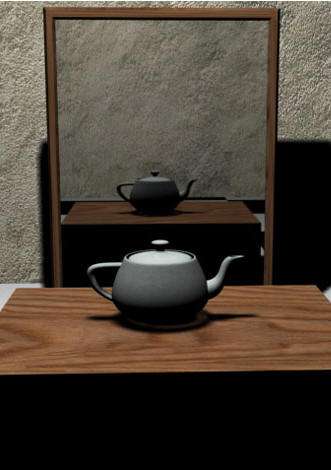
The Essence of the Base is fundamental
voidness. Voidness means that when one examine thoughts, one will find that
they come and go, but do not have any real, independent existence. It is
a phenomenon that only temporarily exists. Before and after a thought there
is only emptiness, voidness. This emptiness is fundamentally pure and clear,
and it is compared to a mirror. A mirror reflects whatever is put in front
of it, but the mirror itself is never changed, nor made impure or obscured.
It always remains empty and clear. Thoughts come and go, but they are just
reflections, they do not change the purity and emptiness of the Natural
State.
The Nature of the Base is the manifest phenomena.
Although phenomena coma and go, and at their essence they are void and empty,
nevertheless phenomena do exist and continue to manifest. This is compared
to the nature of a mirror. Although the mirror remains empty and pure, it
is its nature to continuously reflect what is in front of it.
The Energy of the Base is the way the Base, or the Natural
State, manifests itself. This is compared to the reflections themselves
in the mirror.
Essence, Nature and Energy are all interdependent. One
cannot exist without the other two.
The last one, Energy,
manifests itself threefold: Zal,
Rolba and Dan (untranslatable terms)

Zal (the appearance of a seemingly
external world): is the energy of the individual that appears as a seemingly
external world. The individual sees himself as a separate entity that lives
in outer world of objects. But these outer objects/world are actually projections
from his own energy. This compared to a crystal. Light (energy) enters the
crystal (the individual) and projects into rays and patterns of colors which
are seen as separate from the crystal, but in fact they are functions of
the crystal's nature. In reality there are no external independent or separate
phenomena; they are manifestations of the energy of the individual.
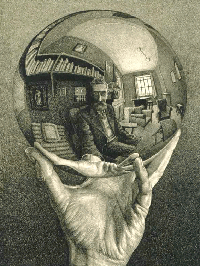
Rolba (the way in which the energy
of an individual manifests): In the individual the energy is experienced
as an internal image. The image might appear as very vivid and real. But
it is just a manifestation of his energy. This is compared to the image
of an object that is seen inside a crystal ball.

Dan (infinite and formless quality
of the energy): the energy of an individual can take any form whatsoever.
Because of the individual karmic vision, its energy will shape itself into
a Body, Voice and Mind with an external environment; life after life. This
is compared to a crystal ball that will take the color of whatever colored
cloth it is put on.
The Path
After the student has been introduced to the Natural
State of being, he need to practice the Path in order to get out of his
dualistic view and condition, and to realize again his true Natural state.
The Path has three aspects: View, Practice
and Attitude.
View means that one has
to observe oneself and discover what one's own condition is in regards to
his body, voice and mind. In this way one will find that one is conditioned
by a lot of things, and stuck in many 'programs'. The body is conditioned
by its living conditions, external influences, nutrients and so on. The
vital body has problems with energy being stuck, not flowing freely, causing
both emotional problems and physical ailments over time. The mental body
has its own imbalances, like a distorted view of the world, mental fixations,
unhealthy thought processes... Here we have the image of the mirror again:
the practitioner needs to look in the mirror of his own being.
Practice strictly means contemplation, that is, one strives
to enter the state of non-duality, the Natural State, and tries to stay
in it for longer and longer periods. Thoughts can come and go, but when
properly centered in the Natural State, the practitioner will not be affected
by those thoughts. The mind itself is not engaged in doing any effort or
work, as it is the case in meditation. Meditation engages the mind to do
something with for example visualization to bring about a state of calm
that is inductive to enter contemplation. Once in contemplation one is totally
present ad aware, and one neither rejects nor follows any thought. Because
we are all different, and our energies are all different, one has to look
inside to find one's own kind of obstacles (=View), and then one has to
choose and employ a meditation technique(s) that will help him to dissolve
those obstacles. Meditation techniques are a help to overcome one's problems,
but they should not be a goal by itself. The focus in Dzogchen is always
on contemplation.
Attitude means that once the practitioner
is able to stay in contemplation, in the Natural State of clear awareness,
during his practice, then he needs to continue, being in this Natural State,
into his daily life. Then he brings his present clear awareness into every
moment of his life. He avoids all distractions that could bring him out
of the Natural State. His mind doesn't wander about the past or future,
but he can actively plan something for the future while remaining clear
and aware of the present. For this he needs to cultivate constant clear
awareness of his entire being. It is an attitude or conduct that will allow
him to gain mastery over the karmic causes in his life. Karmic causes are
twofold: primary and secondary. Primary causes come from the past and can
be experienced as good or bad. But the primary causes need the right conditions
in this life time to be able to manifest themselves, thus they need secondary
karmic causes. When the practitioner has continuous clear awareness of the
Natural State, he is able to recognize when the secondary karmic causes
are arising and prevent the negative ones to develop, while stimulating
the positive ones. Eventually he is not conditioned at all by any experience,
good or bad. Thus he becomes completely liberated from conditioned existence.
He is not limited by the actions of the manifested world. He can act completely
free from all limitations, rules and causes/effects. Such a person may be
seen acting in strange and unexpected ways. A master of himself, he is free
to do what he wants, but he remains aware of the needs and limitations of
other people, and he will always try to help them to observe themselves
and to make their own decisions.
The Fruit
The fruit is Realization. Realization means that
one has made manifest in his awareness that which he in essence always has
been, that is, a state of pure, clear awareness that we call the Natural
State. Through the process of ever deepening awareness of this state one
self-liberates from from the dualistic vision. All passions and all karmic
causes that condition a person to a dualistic world have dissolved. This
person has no attachments to these plays of energies. There is no separation
of subject and object, which is merely a habitual vision of unrealized beings.
A practitioner who remains continuously in the Natural State does not
expect any virtuous qualities to arise or fear bad consequences of wrong
actions. The Natural State is beyond all karmic causality and its effects.
Such a practitioner is not subject to causality or karma. Our existence
as a human being is the result of our impure karmic vision brought about
by causes. It is impure because it is caused by ignorance and the passions
or emotional defilements.
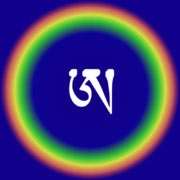
Tibetan letter "A", the symbol of body
of light.
The letter A also symbolizes symbolizing the concept of "infinite
space".
Ultimately, the practitioner dissolves his personal
reality into the Reality of the Natural State. This also means that the
physical body dissolves because it is just one manifestation of our impure
karmic vision. It returns to the primordial energetic essence of the Five
Pure Lights of the Rainbow Body or Light Body. This is not a symbolic thing.
There are a number of documented cases where the practitioner dissolved
his physical body, leaving only hair or nails behind.
|


